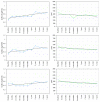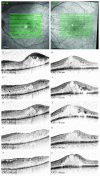Treatment of Diabetic Macular Edema with Intravitreal Antivascular Endothelial Growth Factor and Prompt versus Deferred Focal Laser during Long-Term Follow-Up and Identification of Prognostic Retinal Markers
- PMID: 30364034
- PMCID: PMC6188720
- DOI: 10.1155/2018/3082560
Treatment of Diabetic Macular Edema with Intravitreal Antivascular Endothelial Growth Factor and Prompt versus Deferred Focal Laser during Long-Term Follow-Up and Identification of Prognostic Retinal Markers
Abstract
Purpose: Long-term follow-up of patients with diabetic macular edema (DME) treated with intravitreal antivascular endothelial growth factor (anti-VEGF) combined focal laser and identification of prognostic morphological characteristics.
Methods: Prospective clinical trial (50 treatment-naive eyes) with DME randomized 1 : 1 receiving intravitreal ranibizumab (0.5 mg/0.05 ml) and prompt grid laser compared with ranibizumab and deferred laser. Morphological characteristics potentially relevant for prognosis were assessed at baseline, month 6, month 9, and years 1, 2, 3, 4, and 5 of follow-up.
Results: Although functional results were slightly higher in the prompt group at week 12 (0.5; 20/40 Snellen (SD = 0.04, 0.3 logMAR) versus 0.4; 20/50 Snellen (SD = 0.04, logMAR: 0.4), p=0.4) and month 9 (prompt group: 0.5; 20/40 Snellen (SD = 0.03, 0.3 logMAR) versus deferred group: 0.4; 20/50 Snellen (SD = 0.04, 0.4 logMAR), p=0.4), these were statistically insignificant. There was no significant benefit regarding functionality during long-term follow-up in the prompt group compared to the deferred group. BCVA in the eyes with clusters of hyperreflective foci in the central macular region was inferior compared with the eyes without these alterations at year 5 (0.39; 20/50 Snellen, (SD = 0.25, 0.4 logMAR) versus 0.63; 20/80 Snellen (SD = 0.22, 0.2 logMAR), p < 0.01).
Conclusion: Grid laser and ranibizumab therapy are effective in DME management during the long-term follow-up. Intraretinal hyperreflective material in SD-OCT is negatively related to BCVA.
Figures



Similar articles
-
Intravitreal ranibizumab for diabetic macular edema with prompt versus deferred laser treatment: three-year randomized trial results.Ophthalmology. 2012 Nov;119(11):2312-8. doi: 10.1016/j.ophtha.2012.08.022. Epub 2012 Sep 19. Ophthalmology. 2012. PMID: 22999634 Free PMC article. Clinical Trial.
-
Practical Lessons from Protocol I for the Management of Diabetic Macular Edema.Dev Ophthalmol. 2017;60:91-108. doi: 10.1159/000459692. Epub 2017 Apr 20. Dev Ophthalmol. 2017. PMID: 28427069 Review.
-
Functional and anatomical results after a single intravitreal Ozurdex injection in retinal vein occlusion: a 6-month follow-up -- the SOLO study.Acta Ophthalmol. 2013 Aug;91(5):e340-7. doi: 10.1111/aos.12020. Epub 2013 May 3. Acta Ophthalmol. 2013. PMID: 23638803 Clinical Trial.
-
Spectral-domain optical coherence tomography (SD-OCT) patterns and response to intravitreal bevacizumab therapy in macular edema associated with branch retinal vein occlusion.Graefes Arch Clin Exp Ophthalmol. 2013 Feb;251(2):501-8. doi: 10.1007/s00417-012-2067-8. Epub 2012 Jun 1. Graefes Arch Clin Exp Ophthalmol. 2013. PMID: 22653439
-
Intravitreal Ranibizumab in Diabetic Macular Edema: Long-Term Outcomes.Dev Ophthalmol. 2017;60:63-70. doi: 10.1159/000460496. Epub 2017 Apr 20. Dev Ophthalmol. 2017. PMID: 28427066 Review.
Cited by
-
Predictive factors for treatment outcomes with intravitreal anti-vascular endothelial growth factor injections in diabetic macular edema in clinical practice.Int J Retina Vitreous. 2023 Apr 4;9(1):23. doi: 10.1186/s40942-023-00453-0. Int J Retina Vitreous. 2023. PMID: 37016462 Free PMC article.
-
Therapeutic Effects of Combination Therapy and Photobiomodulation Therapy on Retinal Regeneration.J Lasers Med Sci. 2022 Sep 4;13:e36. doi: 10.34172/jlms.2022.36. eCollection 2022. J Lasers Med Sci. 2022. PMID: 36743147 Free PMC article. Review.
-
Hyperreflective foci in predicting the treatment outcomes of diabetic macular oedema after anti-vascular endothelial growth factor therapy.Sci Rep. 2021 Mar 3;11(1):5103. doi: 10.1038/s41598-021-84553-7. Sci Rep. 2021. PMID: 33658601 Free PMC article.
-
Hyperreflective Retinal Foci (HRF): Definition and Role of an Invaluable OCT Sign.J Clin Med. 2025 Apr 27;14(9):3021. doi: 10.3390/jcm14093021. J Clin Med. 2025. PMID: 40364054 Free PMC article.
-
Sex Differences in Inflammation-Related Biomarkers Detected with OCT in Patients with Diabetic Macular Edema.Ophthalmol Sci. 2024 Jul 18;4(6):100580. doi: 10.1016/j.xops.2024.100580. eCollection 2024 Nov-Dec. Ophthalmol Sci. 2024. PMID: 39280349 Free PMC article.
References
-
- Nathan D. M., Genuth S., Lachin J., et al. Photocoagulation therapy for diabetic eye disease: Early Treatment Diabetic Retinopathy Study Research Group. JAMA. 1985;254(21):3086–3087. - PubMed
LinkOut - more resources
Full Text Sources

